Originally published on SoundStage! Xperience
 In a recent column, I complained about the rapid growth in the number of lookalike headphone amps that are little more than a DAC-amp chip stuffed into an extruded-aluminum box. The Aurender Flow ($1295 USD) is the exact opposite: a product that represents a major rethinking of what people -- specifically, audiophiles -- need in a headphone amp.
In a recent column, I complained about the rapid growth in the number of lookalike headphone amps that are little more than a DAC-amp chip stuffed into an extruded-aluminum box. The Aurender Flow ($1295 USD) is the exact opposite: a product that represents a major rethinking of what people -- specifically, audiophiles -- need in a headphone amp.
I’m writing this review on a sleek, highly portable Hewlett-Packard Spectre laptop equipped with a modestly sized solid-state drive (SSD) that makes me wish I’d spent the money on a bigger drive. Despite my efforts to move my storage-intensive audio and video files to an external drive, my SSD has just 2.2 gigabytes of space left. Yet thanks to the Flow, I can now use this overstuffed computer to access my entire collection of digital music files, and I can add more music without worrying I’ll run out of space.
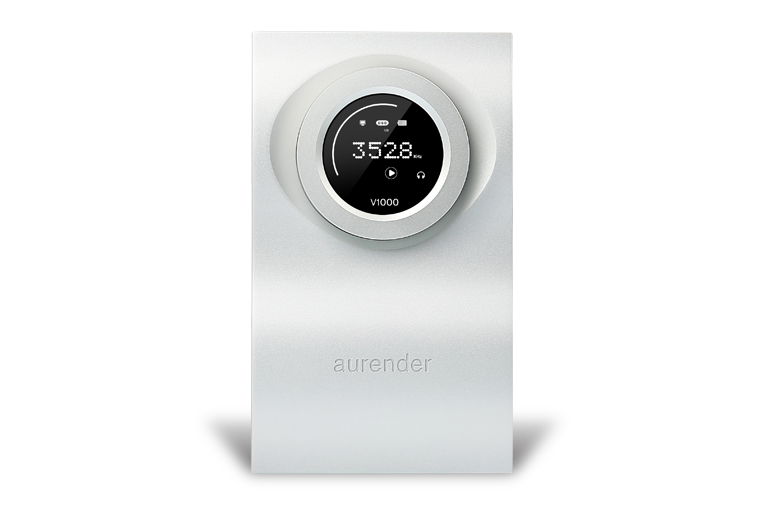
In some ways, the Flow is a typical headphone amplifier-DAC. It connects to a computer via USB, converts digital files (including DSD64/128 and PCM in resolutions up to 32-bit/384kHz) to analog signals, then feeds the music through a high-quality headphone amp with a 1/4” jack.
Yet the Flow radically differs from the usual headphone amp-DAC. What first catches the eye is its appearance: the undulating top panel, the round backlit display surrounded by a volume ring, the brushed-aluminum finish, the absence of visible fasteners except the screws on its bottom surface. It reminds me of the beautiful, attention-getting audio products built by Devialet. Give Aurender a “10” for industrial design.
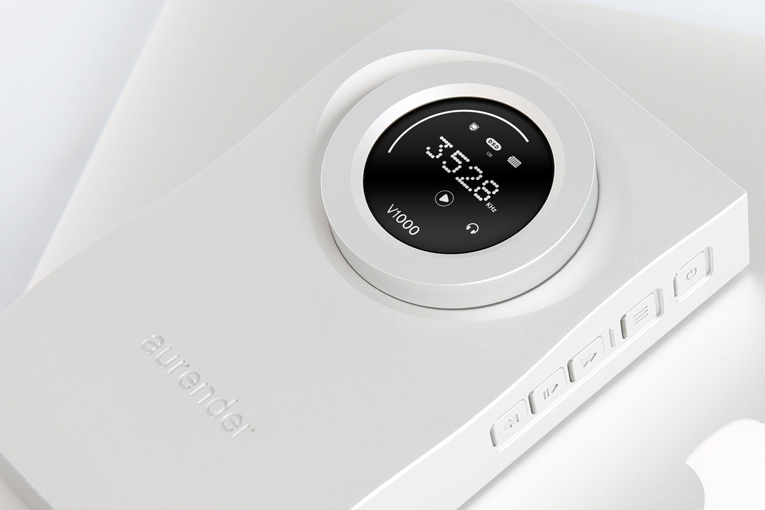
But, for me, what makes the Flow really sing is that it has space inside for an mSATA solid-state drive. When you add the drive, it makes the Flow work like a USB hard drive while it’s working as a headphone amp-DAC. The computer it’s connected to essentially controls everything while the Flow does most of the work. This means that, rather than having to grab my music laptop when I want to play tunes, I can just plug the Flow into whatever computer’s around, and even bring the Flow along on trips -- it weighs just a pound, and measures only 5.3”L x 3.1”W x 1.1”D.
You can get a 256GB mSATA drive for about $120 -- that’s capacious enough to store a sizable collection, even if you have a lot of high-resolution files. Aurender says the Flow can accommodate mSATA drives of up to 1TB capacity.
The Flow can also source digital files from iOS and Android devices, and accepts a TosLink optical digital input -- you can use it with a Blu-ray or CD player, or a TV set. Buttons on the side let you control playback on the computer (although only the Play/Pause button worked with my Windows 8 laptop).
The Flow is powered by an internal rechargeable battery; a single charge is claimed to give seven hours of use. You can charge the battery using a standard USB charger, or through your computer’s USB jack. The Flow’s menu system lets you choose which charging option you prefer.
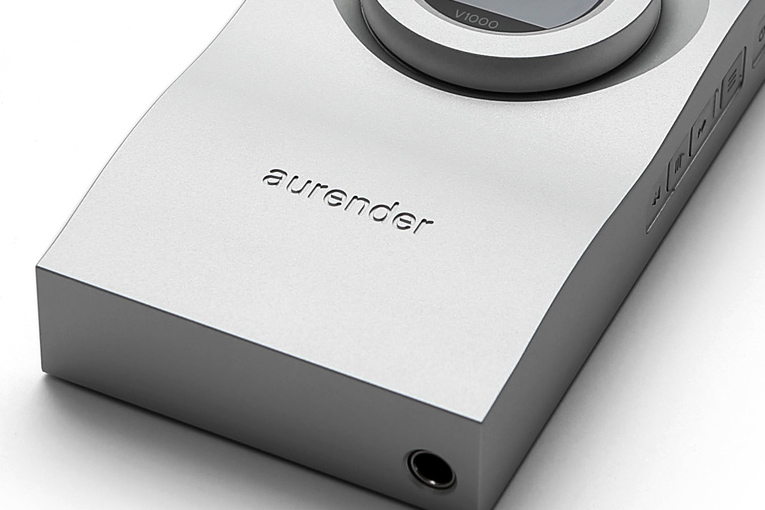
Another thing I really dig about the Flow: Its output impedance is specified as 0.06 ohm. Many headphone amps have an output impedance in the range of 20-30 ohms. With most headphones, this results in a very low damping factor -- i.e., the ability to stop the drivers’ diaphragms from “ringing” after they’re supposed to have stopped moving -- and can have an easily audible effect on the frequency response of headphones whose impedance curve isn’t flat. There are some good reasons why so many headphone amps have high output impedance, but in my opinion, they're based on rather old-school concerns.
There’s more. The Flow offers three digital filter profiles for PCM, plus four different cutoff frequencies for the DSD noise-shaping filter. It can also be set for line output (fixed level, maximum 2 or 5V) or headphone output (variable level). The 2V fixed mode basically turns the Flow into a DAC for use with a conventional, speaker-based stereo system. What’s missing? An analog input that would let you use the Flow with, say, a turntable and phono preamp.
In the box
The Flow includes one thing I really, really wanted it to have: a sturdy leatherette carrying case. Slip the Flow into its case and you can toss it into your computer bag without worrying you’ll scratch the finish.
It also includes numerous cables, which I appreciated. The two most important have a USB 3 Micro B connector at one end (this connects to the Flow), and a standard USB connector at the other (this connects to your computer). One cable is 6” long, the other 4’. I worried that these cables might be difficult to replace -- until I found one on Amazon for $5. A cable with USB Micro plugs at each end allows connection to Android smartphones. (You’ll need a Lightning-to-USB adapter for iOS devices.)
Another nice inclusion is an adapter with a 1/4” stereo headphone plug on one end and two RCA jacks on the other, making it easy to connect the Flow to a stereo system using ordinary interconnects. A TosLink-to-Mini-TosLink optical cable is also included.
Use
As with other USB DACs, you have to install a driver to get the Flow to work with Windows PCs. For Mac users, the operation should be plug’n’play -- as was connecting the Flow to my Samsung Galaxy S6 smartphone. You do, however, have to use the menu system to select which type of connected device you’re using: PC, Mac, iOS, Android, or TosLink.
Every connection worked fine, although I did sometimes hear very subtle, quiet crackles and distortion (kind of like what you hear when you play a beat-up LP) when using the USB connection with my Samsung phone. Because this also happens with my Sony PHA-2 headphone amp-DAC, it’s unlikely that the Flow was the culprit; it’s probably a problem with my phone, or with the implementation of digital audio through the USB outputs of Android phones, which is still a relatively new development.
My review sample of the Flow came with an mSATA drive installed, so I didn’t have a chance to go through the process of installing a drive. However, I did try removing the bottom panel, and extracting and reinserting the mSATA drive; physically, at least, the installation is easy.

In daily use, the Flow was an ergonomic delight. Using the supplied 6” USB cable put the big, smooth-spinning volume control right where you want it: move your hand off your laptop’s keyboard and the volume control is right there. The display inside the volume ring is super-easy to see, and the Play/Pause button on the side is conveniently placed.
I have two complaints. First, every time you disconnect the Flow or the headphones, it resets the volume to -90dB, which effectively mutes the sound. I assume this is so you don’t accidentally blow out your ears by plugging your headphones into the Flow when it's cranked up, but it’s annoying to have to turn the volume up (this takes several twists of the volume ring) every time you change headphones or plug in the Flow. I’ve used innumerable headphone amps that don’t have this feature, and it’s simply not necessary. Aurender should at least issue a firmware update that makes the default setting something like -60dB -- still safe, but less annoying.
Second, the menu readouts are necessarily cryptic -- the Flow has only a four-character alphanumeric display. The abbreviations aren’t entirely intuitive, and I found myself often checking the online manual -- which itself doesn’t seem to be the result of a great deal of effort. Some of its instructions are more descriptions of what the controls do than how to actually use those controls.
Sound
I used the Flow for casual listening for about a month before beginning a serious evaluation. In that time, nothing particularly struck me about its sound. Of course, you could argue that nothing should have struck me about the sound of a headphone amp.
One thing about the Flow that I liked a lot was that it had no problem with the HiFiMan HE-560 headphones, which are currently the most difficult to drive of the headphones I have. Not only could it drive the HE-560s to a comfortable listening level, it could drive them to an uncomfortable listening level about 9dB louder. That’s rare, especially in a compact, battery-powered product like this, and it means that the Flow will probably do a reasonably good job even with headphones that are almost impossible to drive, such as HiFiMan’s HE-6es.
I kept on listening to the Flow, and it kept on sounding good no matter which headphones I used: the hard-to-drive HE-560s, the not-hard-to-drive Oppo PM-3 closed-back planar-magnetics, the easy-to-drive Ultimate Ears Capitol Reference Monitor custom-molded earphones. I couldn’t identify any particular character to the sound, or any way in which the Flow excelled or lagged behind.
I tried the different PCM filter options, but the differences were way too subtle and hard to hear to hold my attention for long. I ended up sticking with the default setting, which is for a slow-rolloff filter. (At the time of writing, the manual incorrectly listed the fast-rolloff filter as the default; the other option is a minimum-phase filter.) The manual says there’s a slight attenuation with the slow-rolloff filter, but I couldn’t hear it. Small wonder: Using my handheld audio analyzer (an NTi Minilyzer) and a 1kHz test tone, I measured the difference at 0.004dB.
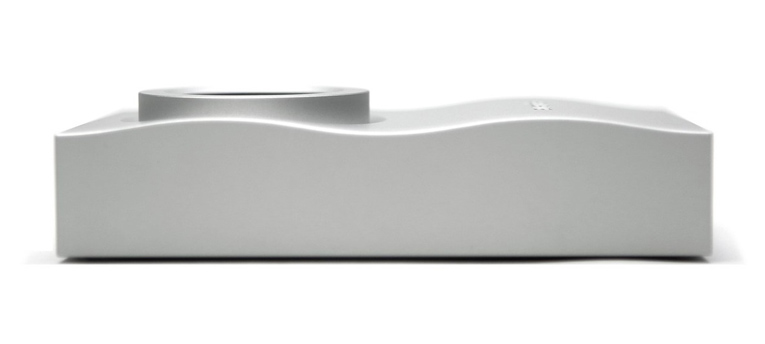
To get a better idea of the Flow’s sound, I set up a comparison with my Sony PHA-2 ($595), which in many ways is quite similar to the Aurender. It doesn’t have the Flow’s cool design, advanced features, or mSATA bay, but otherwise it does pretty much the same thing: It’s a portable, battery-powered USB headphone amp-DAC that handles PCM in resolutions up through 24/192, as well as DSD64/128. I used the HiFiMan HE-560s for this comparison, figuring they’d present the toughest challenge, and matched the playback levels to within 0.017dB using the Minilyzer.
I tried several of my favorite test tracks with both headphone amp-DACs, and the most readily apparent difference was that I had to turn the Sony all the way up to drive the HE-560s to a satisfying level, while the Flow could play the HiFiMans another 8dB louder. But as I listened to more files of various formats, other major differences -- surprising differences -- began to reveal themselves.
In every test with PCM files -- everything from 256kbps MP3s to 24/96 FLAC -- the Flow sounded better. That’s actually a good way to describe the difference: It just sounded better. The tonal balances of the two amp-DACs sounded the same, but the Flow had a smoother, less grainy sound, revealed a little more detail, and presented a more open, spacious soundstage.
For example, with “Mary Don’t You Weep,” from Mumtaz Mahal, a collaboration between blues singer and guitarist Taj Mahal and Indian musicians N. Ravikiran and V.M. Bhatt (16-bit/44.1kHz WAV, Water Lily Acoustics), Mahal’s voice sounded clearer and more open, more as if I were hearing the live feed of the recording rather than something that had been passed through numerous layers of amplification, processing, and downsampling. The guitars and Bhatt’s mohan vina (a sort of Indian guitar) had a bit more detail, but I could also better sense their positions in the recording venue; with the Sony, it was a bit more as if I were hearing them perform in a hallway -- an exaggeration, but the best description of the difference I can think of.
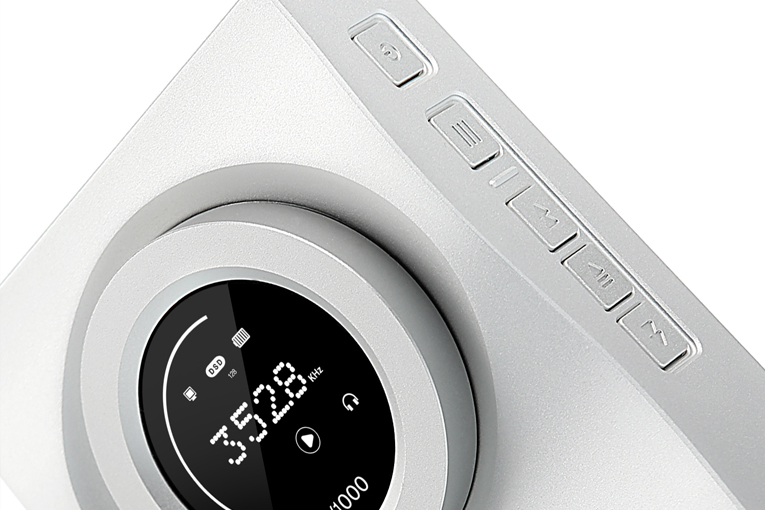
This held true with high-resolution PCM, too. When I played “This Little Light of Mine,” sung by the West New York Spiritual Choir on Dr. Chesky’s Ultimate Headphone Demonstration Disc (24/96 FLAC, Chesky JD361), the voices sounded smoother and less grainy, and I got a more detailed sense of the acoustic of the recording space. The Flow sounded smoother and more natural than the PHA-2, even with multitracked, overdubbed studio recordings such as “Long Distance Runaround,” from Yes’s Fragile (24/96 FLAC, Atlantic/Rhino).
But when I played DSD files, the results in some ways were reversed. For example, with James Englund and Bobo’s “Dangerous World,” from Special Event 29 (2.8MHz DSD, Blue Coast), the Flow still seemed to have the slightly more open sound -- but, paradoxically, the PHA-2 sounded smoother, clearer, more detailed. Maybe Sony’s learned a few secret tricks in its nearly two decades of experience with DSD. However, this isn’t a huge concern for me -- I have only a few DSD files -- and the combination of Aurender Flow and HiFiMan HE-560s still conveyed the rather shocking realism of this track, which was recorded, mixed, and mastered by Cookie Marenco, founder of Blue Coast Records.
Conclusion
When Devialet introduced their great-sounding, ultrasleek, digital integrated amps, they rocked the world of high-end audio. Aurender has now basically applied the same concept to the headphone amplifier-DAC: The Flow is an upscale product with excellent sound quality and ergonomics, and impressive versatility. I expect it to be a big hit with headphone enthusiasts whose primary source component is a laptop computer.
. . . Brent Butterworth
Associated Equipment
- Headphones and earphones -- HiFiMan HE-560, Oppo Digital PM-3 headphones; Ultimate Ears Capitol Reference Monitors custom-molded earphones
- Headphone amplifier-DAC -- Sony PHA-2
- Sources -- Hewlett-Packard Spectre laptop, Samsung Galaxy S6 Android phone
Aurender Flow Headphone Amplifier-DAC
Price: $1295 USD.
Warranty: Two years parts and labor.
Aurender
209 North Victory Boulevard
Burbank, CA 91502
USA
E-mail:
Website: www.aurender.com




